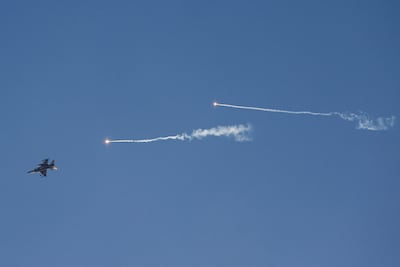Live updates: Follow the latest on Israel-Gaza
Israel’s Prime Minister Benjamin Netanyahu has backed the head of the air force's decision to dismiss reservists who signed a letter calling on the government to prioritise releasing hostages in Gaza over fighting Hamas, even if it means ending the war.
Mr Netanyahu said the roughly 1,000 signatories, made up of veterans and reservists including senior officers and pilots, are “an extremist fringe group that is trying again to break Israeli society from within”.
The act of protest has nonetheless rattled the defence establishment, which fears that an increasing number of reservists across the military are unlikely to return to duty out of anger at the government’s decision to intensify fighting in Gaza. Many Israelis say the action amounts to a death sentence for remaining hostages in the strip. Polling consistently shows that a majority of Israelis want Mr Netanyahu to prioritise releasing hostages.
Israel’s military said most of the signatories of the letter were not active reservists, but did not give an exact number. A military official described the protest as "a serious breach of trust between commanders and subordinates".
It added: "With the full backing of the Chief of the General Staff, the commander of the [air force] has decided that any active reservist who signed the letter will not be able to continue serving."
The air force has played a vital role during the war, carrying out a massive bombardment of Gaza, as well as related attacks in Lebanon, Syria, Yemen and the occupied West Bank. The air force would also be at the centre of a potential attack on Iran’s nuclear facilities, which Mr Netanyahu has consistently warned is on the table.
The letter said the war now “serves mainly political and personal interests, not security interests”. It added: “The continuation of the war does not contribute to any of its declared goals and will lead to the deaths of the hostages, Israeli soldiers and innocent civilians, and to the attrition of the [Israeli military] reserve forces.”
It criticised the government for walking away from a ceasefire deal, which saw a number of hostages, dead and alive, released in exchange for Palestinian detainees and prisoners. “Only a deal can bring back the hostages safely, while military pressure mainly leads to the killing of the hostages and the endangering of soldiers,” it said.
Air Force Commander Tomer Bar had met reservists to convince them not to sign the letter, reportedly prompting a small number to change their mind.
The air force has long been one of the country’s most prestigious institutions, with a reputation built on successful operations such as surprise attacks on Arab armies during the 1967 War and the bombing of Iraqi nuclear reactors.
Israel’s military relies heavily on reservists as it maintains a relatively small standing force. After the October 7 Hamas attacks that started the war, all branches of the military benefitted from significant enthusiasm for service. However, call-up rates have since dropped, with many people critical of the burden it places on their personal and professional lives.
There is also major criticism of exemptions given to ultra-Orthodox Israelis, whose representatives form an important bloc in Mr Netanyahu’s far-right coalition.
In his response to the letter on Thursday, Mr Netanyahu said air force personnel “already tried to do this before October 7”, in reference to similar letters and rumours of mass walkouts in protest against his government's plans to overhaul the judiciary, which critics said would end democracy in Israel.
The prime minister said “Hamas interpreted the calls for refusal [before October 7] as weakness”.
UAE currency: the story behind the money in your pockets
Iftar programme at the Sheikh Mohammed Centre for Cultural Understanding
Established in 1998, the Sheikh Mohammed Centre for Cultural Understanding was created with a vision to teach residents about the traditions and customs of the UAE. Its motto is ‘open doors, open minds’. All year-round, visitors can sign up for a traditional Emirati breakfast, lunch or dinner meal, as well as a range of walking tours, including ones to sites such as the Jumeirah Mosque or Al Fahidi Historical Neighbourhood.
Every year during Ramadan, an iftar programme is rolled out. This allows guests to break their fast with the centre’s presenters, visit a nearby mosque and observe their guides while they pray. These events last for about two hours and are open to the public, or can be booked for a private event.
Until the end of Ramadan, the iftar events take place from 7pm until 9pm, from Saturday to Thursday. Advanced booking is required.
For more details, email openminds@cultures.ae or visit www.cultures.ae
If you go...
Fly from Dubai or Abu Dhabi to Chiang Mai in Thailand, via Bangkok, before taking a five-hour bus ride across the Laos border to Huay Xai. The land border crossing at Huay Xai is a well-trodden route, meaning entry is swift, though travellers should be aware of visa requirements for both countries.
Flights from Dubai start at Dh4,000 return with Emirates, while Etihad flights from Abu Dhabi start at Dh2,000. Local buses can be booked in Chiang Mai from around Dh50
UAE currency: the story behind the money in your pockets
SRI LANKA SQUAD
Upul Tharanga (captain), Dinesh Chandimal, Niroshan Dickwella
Lahiru Thirimanne, Kusal Mendis, Milinda Siriwardana
Chamara Kapugedara, Thisara Perera, Seekuge Prasanna
Nuwan Pradeep, Suranga Lakmal, Dushmantha Chameera
Vishwa Fernando, Akila Dananjaya, Jeffrey Vandersay
Key changes
Commission caps
For life insurance products with a savings component, Peter Hodgins of Clyde & Co said different caps apply to the saving and protection elements:
• For the saving component, a cap of 4.5 per cent of the annualised premium per year (which may not exceed 90 per cent of the annualised premium over the policy term).
• On the protection component, there is a cap of 10 per cent of the annualised premium per year (which may not exceed 160 per cent of the annualised premium over the policy term).
• Indemnity commission, the amount of commission that can be advanced to a product salesperson, can be 50 per cent of the annualised premium for the first year or 50 per cent of the total commissions on the policy calculated.
• The remaining commission after deduction of the indemnity commission is paid equally over the premium payment term.
• For pure protection products, which only offer a life insurance component, the maximum commission will be 10 per cent of the annualised premium multiplied by the length of the policy in years.
Disclosure
Customers must now be provided with a full illustration of the product they are buying to ensure they understand the potential returns on savings products as well as the effects of any charges. There is also a “free-look” period of 30 days, where insurers must provide a full refund if the buyer wishes to cancel the policy.
“The illustration should provide for at least two scenarios to illustrate the performance of the product,” said Mr Hodgins. “All illustrations are required to be signed by the customer.”
Another illustration must outline surrender charges to ensure they understand the costs of exiting a fixed-term product early.
Illustrations must also be kept updatedand insurers must provide information on the top five investment funds available annually, including at least five years' performance data.
“This may be segregated based on the risk appetite of the customer (in which case, the top five funds for each segment must be provided),” said Mr Hodgins.
Product providers must also disclose the ratio of protection benefit to savings benefits. If a protection benefit ratio is less than 10 per cent "the product must carry a warning stating that it has limited or no protection benefit" Mr Hodgins added.




